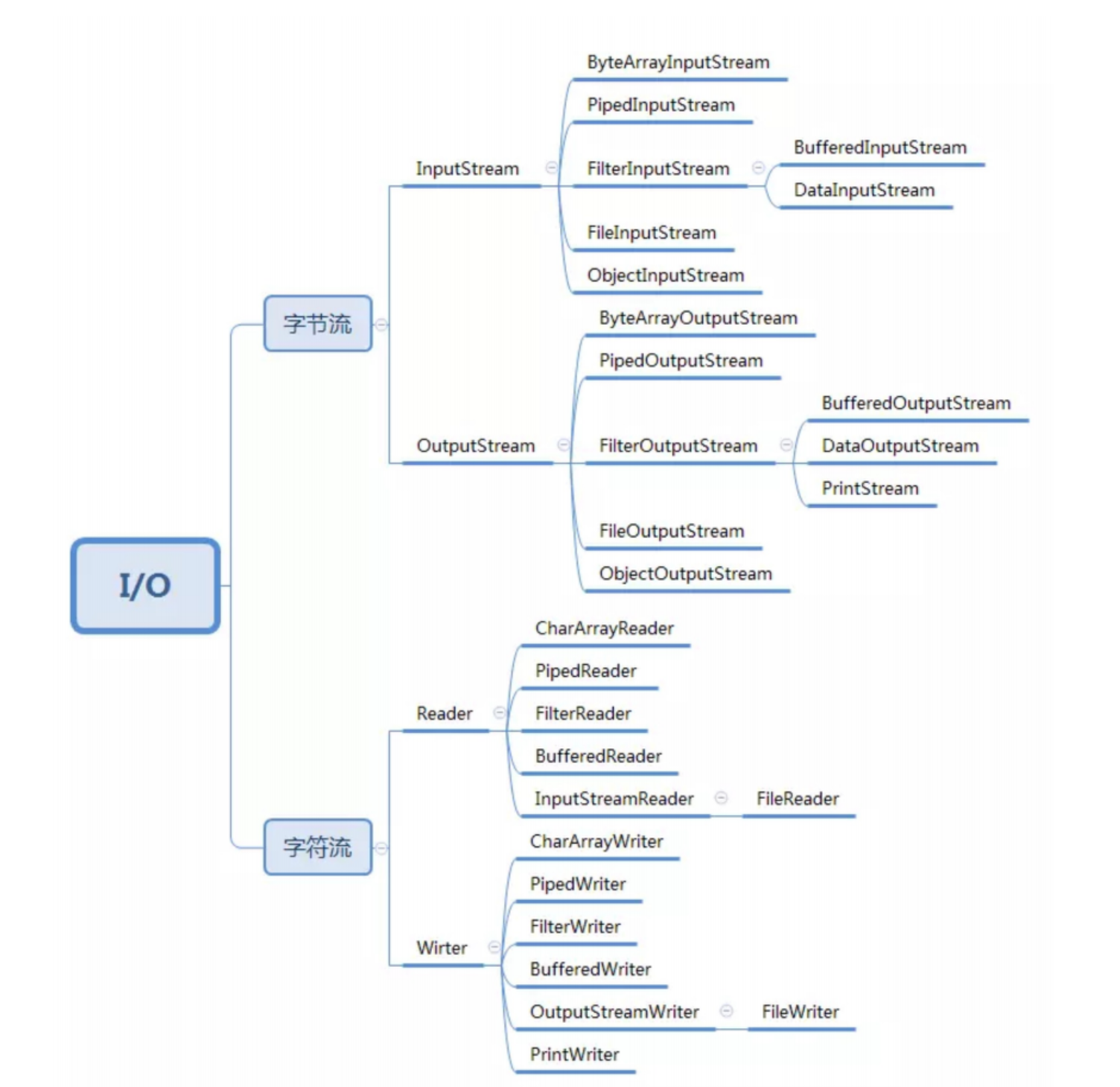装饰器模式
Decorator Pattern 装饰器模式的代码结构与桥接模式十分相似,但是解决的问题却不同。
从Java IO类中理解装饰器模式

下面是Java的IO类的一个应用实例:
InputStream in = new FileInputStream("/user/guank/test.txt");
InputStream bin = new BufferedInputStream(in);
byte[] data = new byte[128];
while (bin.read(data) != -1) {
//.....
}
基于继承的设计方案
如果 InputStream 只有一个子类 FileInputStream 的话,那我们在 FileInputStream 基础之上,再设计一个孙子类 BufferedFileInputStream,也算是可以接受的,毕竟继承结构还算简单。但实际上,继承 InputStream 的子类有很多。我们需要给每一个 InputStream的子类,再继续派生支持缓存读取的子类。
除了支持缓存读取之外,如果我们还需要对功能进行其他方面的增强,比如下面的DataInputStream 类,支持按照基本数据类型(int、boolean、long 等)来读取数据。
InputStream bin = new BufferedInputStream(in);
DataInputStream din = new DataInputStream(in);
int data = din.readInt();
在这种情况下,如果我们继续按照继承的方式来实现的话,就需要再继续派生出DataFileInputStream、DataPipedInputStream 等类。如果我们还需要既支持缓存、又支持按照基本类型读取数据的类,那就要再继续派生出 BufferedDataFileInputStream、BufferedDataPipedInputStream 等 n 多类。这还只是附加了两个增强功能,如果我们需要附加更多的增强功能,那就会导致组合爆炸,类继承结构变得无比复杂,代码既不好扩展,也不好维护。
基于装饰器模式的设计方案
public abstract class InputStream implements Closeable {
public int read(byte b[]) throws IOException {
return read(b, 0, b.length);
}
public int read(byte b[], int off, int len) throws IOException {
Objects.checkFromIndexSize(off, len, b.length);
if (len == 0) {
return 0;
}
int c = read();
if (c == -1) {
return -1;
}
b[off] = (byte)c;
int i = 1;
try {
for (; i < len ; i++) {
c = read();
if (c == -1) {
break;
}
b[off + i] = (byte)c;
}
} catch (IOException ee) {
}
return i;
}
public long skip(long n) throws IOException {
long remaining = n;
int nr;
if (n <= 0) {
return 0;
}
int size = (int)Math.min(MAX_SKIP_BUFFER_SIZE, remaining);
byte[] skipBuffer = new byte[size];
while (remaining > 0) {
nr = read(skipBuffer, 0, (int)Math.min(size, remaining));
if (nr < 0) {
break;
}
remaining -= nr;
}
return n - remaining;
}
public int available() throws IOException {
return 0;
}
public void close() throws IOException {}
public synchronized void mark(int readlimit) {}
public synchronized void reset() throws IOException {
throw new IOException("mark/reset not supported");
}
public boolean markSupported() {
return false;
}
}
-------------------------------------------------------------------------------
public
class FilterInputStream extends InputStream {
protected volatile InputStream in;
protected FilterInputStream(InputStream in) {
this.in = in;
}
}
----------------------------------------------------------------------------------
public
class BufferedInputStream extends FilterInputStream {
public BufferedInputStream(InputStream in) {
this(in, DEFAULT_BUFFER_SIZE);
}
public BufferedInputStream(InputStream in, int size) {
super(in);
if (size <= 0) {
throw new IllegalArgumentException("Buffer size <= 0");
}
buf = new byte[size];
}
}
---------------------------------------------------------------------------------
public
class DataInputStream extends FilterInputStream implements DataInput {
public DataInputStream(InputStream in) {
super(in);
}
//...................
}
上面的代码使用了继承了同一父类,并且通过组合的方式将自己和父类组合在一起。
从 Java IO 的设计来看,装饰器模式相对于简单的组合关系,还有两个比较特殊的地
方。
-
第一个比较特殊的地方是:装饰器类和原始类继承同样的父类,这样我们可以对原始类“嵌
**套”多个装饰器类。**比如,下面这样一段代码,我们对 FileInputStream 嵌套了两个装饰
器类:BufferedInputStream 和 DataInputStream,让它既支持缓存读取,又支持按照基
本数据类型来读取数据。
InputStream in = new FileInputStream("/user/guank/test.txt"); InputStream bin = new BufferedInputStream(in); DataInputStream din = new DataInputStream(bin); int data = din.readInt(); -
第二个比较特殊的地方是:装饰器类是对功能的增强,这也是装饰器模式应用场景的一个重
**要特点。**实际上,符合“组合关系”这种代码结构的设计模式有很多,比如之前讲过的代理
模式、桥接模式,还有现在的装饰器模式。尽管它们的代码结构很相似,但是每种设计模式
的意图是不同的。就拿比较相似的代理模式和装饰器模式来说吧,代理模式中,代理类附加
的是跟原始类无关的功能,而在装饰器模式中,装饰器类附加的是跟原始类相关的增强功
能。
//代理模式的代码结构(下面的接口也可以替换成抽象类) public interface IA { void f(); } public class A implements IA { @Override public void f() { } } public class AProxy implements IA { private IA a; public AProxy(IA a) { this.a = a; } @Override public void f() { //新添加的代理逻辑 a.f(); //新添加的代理逻辑 } } ----------------------------------------------------------------------- 装饰器模式的代码结构 public interface IA { void f(); } public class A implements IA { @Override public void f() { } } public class ADecorator implements IA { private IA a; public ADecorator(IA a) { this.a = a; } @Override public void f() { //功能增强代码 a.f(); //功能增强代码 } }
装饰器模式的注意点
-
对于装饰器模式而言,即使装饰器类不需要对一些功能点进行增强,装饰器类也需要把原始类的方法重新实现一下,简单包裹对原始类的调用。具体代码如下:
public class FilterInputStream extends InputStream { protected volatile InputStream in; protected FilterInputStream(InputStream in) { this.in = in; } //f()函数不需要增强,只是重新调用一下原始类的f()函数 public void f() { in.f(); } }




评论区